
14 minute read
A Sip of Salvation A Thirst for Life
by Anna M. Ross
Advertisement
—John 7: 37-39
Water is both essential for survival and the essence of salvation. A five-lettered word of such importance that it appears in the Bible 722 times, mentioned more than faith, hope, worship, even prayer. Water is an inorganic compound that transcends science to speak to the soul; a symbol of purification and promise common to all faiths and cultures. It’s worth for existence is more powerful than love.
The juxtaposition of heaven and earth manifests itself with water. From the skies, the rain and snow fall to cover, to cool; from the earth, water seeps and collects to nourish, to cleanse. Some places often get too much rain, others far too little. But for God in heaven and Jesus on earth, the Holy Spirit joins the two to become one in salvation. The living water that Jesus spoke of to the woman at the well, is as essential to one’s being as the lifegiving water that all human beings must have to survive.
Water creates images of pleasure, idioms that touch and tease: a drop of kindness, a splash of color, a roar of laughter, a wave of emotion; the clichés of being wet behind the ears, raining cats and dogs, leading a horse to water. Water is tapped and pumped, drained and poured. It comes in many forms yet remains unique to each form: the snowflake, the raindrop, the ocean wave.
Water is a question – Will it rain today? Will the storm pass soon? Are the streets flooded?
For many Americans, water is readily available and the act of getting it automatic. To put water usage in the U.S. into perspective, the average person uses over 101.5 gallons of water a day; an average often surpassed before the family leaves the house.
But for those who live outside the United States, who share our border or simply share in the global world continents away, poverty exists on an unfathomable scale. A world where women and children of a village must choose between having an indoor toilet or a common well. Many have never seen water that is clear or tasted water that is safe. Their questions are basic: How far must I walk to get water? Should I bring my own water to the hospital? Is the water from the river safe to drink?
There’s a final question, a metaphor that instinctively causes one to pause: “Does it matter if the glass is halffull or half-empty if no one has a glass or the water to fill it?”
Executive Director Sister Mary Louise Stubbs has served at International Project Services (IPS) since 2014, an eight-year ministry that has flourished under her leadership. From her office in Southfield, Michigan, a suburb of Detroit, Sister Mary Louise and staff work tirelessly to help those whose needs are great. With over 1,420 projects in 69 countries, Sister Mary Louise and her team often touch every time zone in carrying out the Daughters’ charism of “decreasing human suffering and increasing potential.”
Established in 2004 by the Superioress General Council and her Council in Paris, France, IPS became fully operational in 2006, with Sister Felicia Mazzola serving as its first director. “When I arrived,” Sister Mary Louise recalls, “Sister Felicia had accomplished so much, had things running so efficiently and smoothly, that she made my stepping into the role easy.”
Today by telephone, Sister Mary Louise nixes the notion that she doesn’t sleep; however, when questioned what she finds the most challenging of her IPS executive directress role, Sister Mary Louise admits that “it is the urgency of the Daughters’ missions – no matter how small or how far away – that I find the most difficult to turn off thinking about. There is always a fax or a ping in the night to wake up to.”
The eldest of seven children, the native Canadian came to the U.S. during her teen years. “We lived in Illinois, and I received a scholarship to a Catholic high school. I was interested in scientific research and while inquiring about a position at the Hansen’s Disease facility in Carville, Louisiana, I learned about the Daughters.
When I went to visit the community in St. Louis, I put in my application that same day. Most people, including my parents, would call me headstrong. My siblings liked to call me bossy.”
After earning her bachelor’s degree in nursing from Marillac College, Sister Mary Louise served in healthcare, from being a staff nurse through becoming vice president at Hotel Dieu Hospital in New Orleans.
Throughout the years and following ministries, Sister Mary Louise honed the skills of effective leadership – to quickly process information and turn it into action, have a vision that encourages and inspires, develop and revisit often a strategic plan that is effective and decisive, and sacrifice set-in-stone methods to pivot, to sidestep creatively, instinctively, rather than yield to the chorus.
Above all, for Sister Mary Louise, one shared with her Sisters throughout the world – to serve those in need, the marginalized of society. Every IPS brochure features the precept: to decrease suffering and recognize potential.
“They ask so little and give back so much in return,” says Sister Mary Louise. A prolific writer and public speaker, Sister Mary Louise thrives on the challenge of playing matchmaker between the projects and the donors who support it. She enjoys mingling at social events and her wry, somewhat self-deprecating, humor allows ease and approachability. A story that elicits a laugh is relating a visit a few years past to her long-ago directress, who, taking Sister Mary Louise’s hand said dolefully: “All the good ones are gone.”
Sisters Felicia Mazzola and Francine Brown working at IPS.
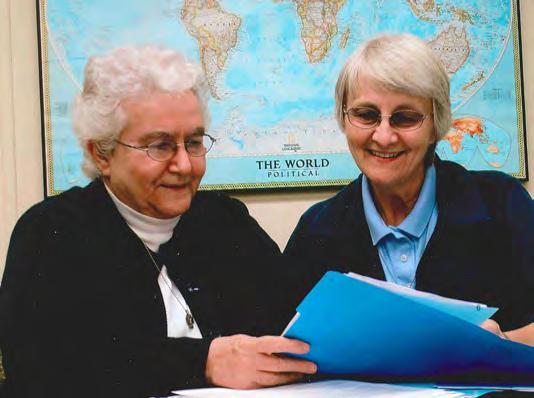
For a project to be accepted at IPS, it must meet seven criteria, including prior approval of the Superioress General and her Council’s if the proposed project exceeds the Province’s authorized expenditure limit. The IPS Application Form must be filled out in English, French or Spanish, all information with photos included and emailed. The project should not be an immediate need and the expectation is that funds can be obtained for the project.
Project requests or proposals are written by the Daughters on mission themselves, having been mentored by Sister Mary Louise and others through workshops and programs such as the African Sisters Education Collaborative to empower and educate the development world. Those who have been taught, in turn, can pass along their knowledge, what works and what doesn’t. Collaboration and networking are invaluable tools to instill confidence and ensure success in project writing and ultimately, in development partnership.
Since 1993, the United Nations has celebrated World Water Day on March 22, an international response to raise awareness to address the needs of the 2.2 billion people living without access to safe water. Cardinal Peter Turkson, former prefect of the Dicastery for Promoting Integral Human Development, stated that “the Holy See has been working for years to realize the vision of ensuring that everyone has access to clean, potable water.”
Pope Francis mentioned the theme of access to safe and drinkable water in his 2015 encyclical Laudato Si’ and again in his 2019 message of Care of Creation. As Turkson continued, “Access to drinkable water and hygienic services is a matter of human dignity.” Each World Day has a theme and 2020’s was “Water and Climate Change.” What sprang from that year’s theme was the WASH project (Water, Sanitation and Hygiene), launched by the Dicastery in order to gain understanding and assess the current state of 150 healthcare facilities (from dispensaries to hospitals) that belong to the Catholic Church in 23 countries. A project – or the lack thereof – that became very dear to Sister Mary Louise’s and Daughters’ missions around the world.
An interview between Sister Mary Louise and Sister Adela Orea, D.C. (who passed away within a month of the completion of her water and sanitation project) illustrates the long struggle of meeting the basic needs of the people the Daughters have served for the past 400 years. Sister Adela spent 37 years on mission ministering in the remote and impoverished areas of Mexico and Cameroon and, as Sister Mary Louise states, “What’s more remarkable is that Sister Adela had done so most often without running water.”
While women around the world are often encouraged to give birth in areas where they have access to prenatal care and the benefit of a skilled attendant, many women choose to stay home where they are without safe water, basic toilets, or soap and hygiene practices. Just three years ago, in 2019, UNICEF released a report attributing 2.4 million newborn deaths to the lack of these essentials.
Fortunately, Sister Adela lived to witness the WASH improvements made at the San Carlos de Altamirano Chiapas Hospital, thanks to an IPS donor. Because of the money received, “We were able to pipe water from a local spring to a large reservoir, where we pipe water to a series of tanks which provide water to the entire hospital so that we can have proper hygiene conditions,” Sister Adela was quoted as saying, “and conditions have changed for the better 180 degrees!”
Over one hundred project requests are received in Sister Mary Louise’s inbox each year; all in need of financial support, each as crucial to a mission as the
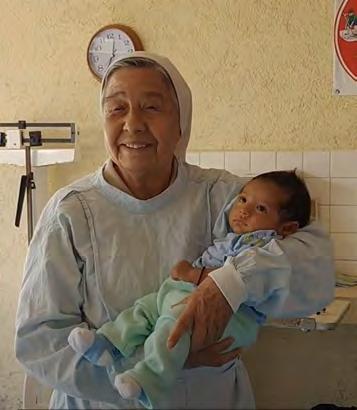
DREAM Meeting, Rome, 2019 (L-R): Sisters Friederika Kuhnel, Mary Louise Stubbs, and Bibiane Bokamba
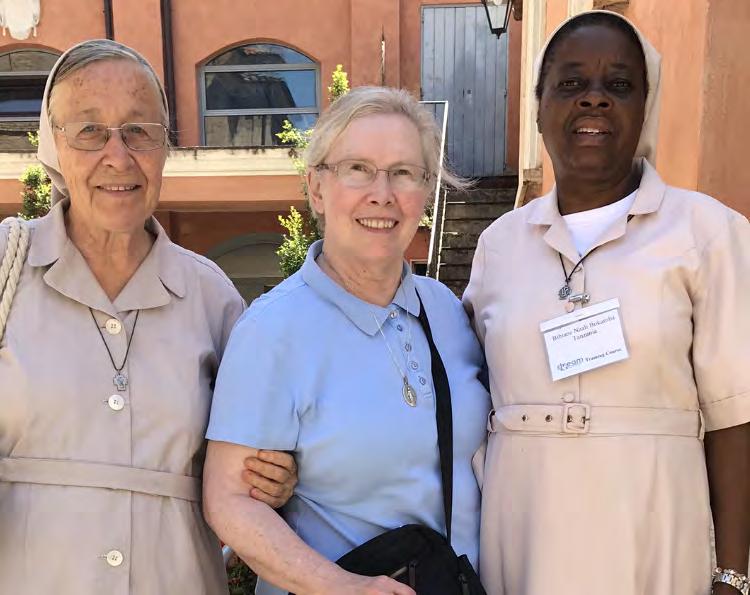
Sister Adela Orea, Chiapas, Mexico
next one’s. On the IPS website www.daughtersips.org, a dropdown lists the country, the completed projects and the ones in progress. The projects range from small to large, from rural to urban. A kaleidoscope of colorful images on the screen highlights the work – and success – of a project, particularly those whose lives have been changed forever by a water filter system, a new water storage tank, or new toilets for a center that had four bathrooms to accommodate sixty patrons.
The personal story below of Daughter of Charity Sister Felekech in Addis Ababa, Ethiopia, follows the fulfillment of a dream to provide water to a town: from an idea to a request to an assigned project number to construction to completion. And finally, to a Daughter dancing on water raining upward from a well.
When asked by Sister Mary Louise via email to agree to an interview, Sister Felekech’s reply was immediate: “Of course I would be willing!” she wrote, “but it is more convenient for me through email as the telephones are either not clear or cut you off.” Before closing, Sister Felekech hastens to reassure, “Oh Sister, I will happily tell them how it has [new water system] saved our lives.”
Sister Felekech responded to a set of questions with a six-page set of answers (and apologies for any lack of clarity since English is her third language; her eloquent answers ensured no apologies were necessary).
“I have been the Sister Servant and Provincial Secretary for the Provincial House in Addis Ababa, Ethiopia for the past nine years,” Sister Felekech writes. “I’ve also served as Project Director for IPS Projects since 2015, and I currently share the Provincial House with the Provincial and 13 Sisters.
The Daughters of Charity arrived in Ethiopia in November 1927. Three Sisters were sent to open St. Mary’s Commercial School (now St. Mary’s Catholic School) to provide education from kindergarten through Grade 12.

The first Ethiopian Sister entered in 1952, and until 1972 the Ethiopian Daughters went to France for formation. In 1972, formation was changed to take place in Ethiopia. The country became an independent province in 2001.”
On her journey as a Daughter, Sister writes, “I grew up in the countryside, and as a young girl, I was very interested in the Church and God. I was brought up in the Orthodox Church, which is dogmatically very near to the Catholic Church. I had a schoolfriend who was a Catholic and interested in joining the Daughters of Charity. I loved discussing with her about God, Church and how we could serve God.
“As my parents were very strict Orthodox, I never dreamt of becoming a Catholic. One day, I jokingly asked my parents if I could become a Catholic and a Sister, and my father answered, ‘If you want, why not?’ To make sure he didn’t change his mind the next day, I went to the Catholic Church (which was 30 minutes away) and asked a Holy Priest, ‘Father, can I become a Catholic and become a Sister?’
“Usually, it takes two years to convert. For me it was instant,” she recalls. “It is the love of God which led me to become a Daughter of Charity. I have found my place.”
In Addis Ababa, the largest city in Ethiopia and the country’s capital, “families are very close, and the extended family support each other. In some cases, they live together. In the towns, everybody emphasizes the education of children, while in the countryside, the awareness of the need for education was low but now it is improving.
Madagascar, East Africa
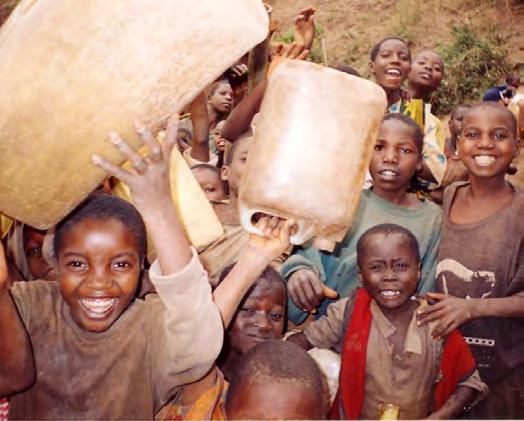
Republic of Burundi, East Africa
Dancing on a borehole, Addis Ababa
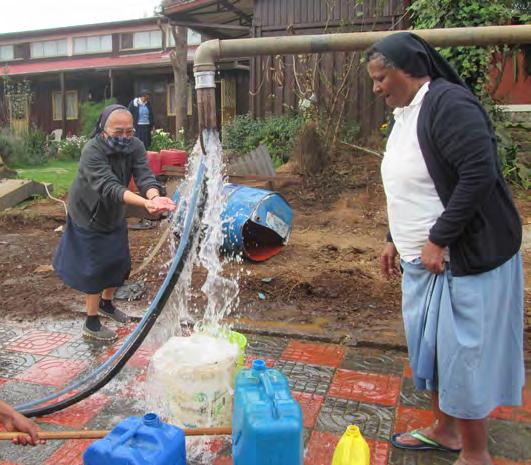
In response to the question of what the capital city is like, Sister Felekech writes, “Addis Ababa is a melting pot for all the tribes coming from all corners of the country. In addition, it is considered as a capital of Africa. Because Ethiopia was not colonized, it has called the attention of the African peoples and the African Union seat is based in Addis Ababa. There are museums and churches to visit.”
The installation of the new water system at St. Mary’s School and Laboratory brings smiles and much joy to the children, parents, teachers and us,” Sister says. “As you are aware, children love water and they keep drinking and washing hands, even when they don’t need to.”
Before the system was installed, government/ municipality water was used, and in most cases, says Sister, “this water comes only once a week. If families run out, they must go purchase it or fetch water from the rivers/springs. We often didn’t have enough water at the school for the whole week, so we would have to buy it from the lorries, which was expensive and not that clean for drinking.”
With fresh water on hand, “Our school is very conducive for learning and the teaching process. It was hard to teach when the students were complaining of being thirsty. At times, if there wasn’t any water, we had to close the school and send the children home. Additionally, it was difficult to control the toilets with over 1,800 students. Now, there is flushing water and the place is easily kept clean. Even the school garden is flourishing, and we can now keep the Laboratory clean and comfortable.” The work is not finished yet in Addis Ababa. When asked, ‘What’s next?’ Sister Felekech reveals the Daughters’ next project, another water well for a second house in Addis Ababa. “People in the neighborhood have no water and the problem is serious. Now we know that it is a life-saving project, we will look for funds through the kind help of Sister Mary Louise and IPS.”
Today, though, Sister Felekech writes, “The water problem is only a history. There’s no need to buy water anymore, there is water in abundance. This water is God-given, and we are blessed.”
There is no shortage of needs in the world, still much work to be done. The care of creation is in all our hands. Through the work of Sister Mary Louise, through the Daughters on mission around the world, through the generosity of the donors and benefactors, works such as those of Sister Felekech’s will continue.
The late Sister Adela spoke for all Daughters at home and overseas when she said, “Water and faith are intertwined. And whoever has water, has life.”
Through IPS, the Daughters can continue to serve as a conduit between those who are suffering and those who can help. Whether the gift of water is from those who provide it or for those who receive it, Psalm 23 offers a glimpse into the sip of salvation and the thirst for life:
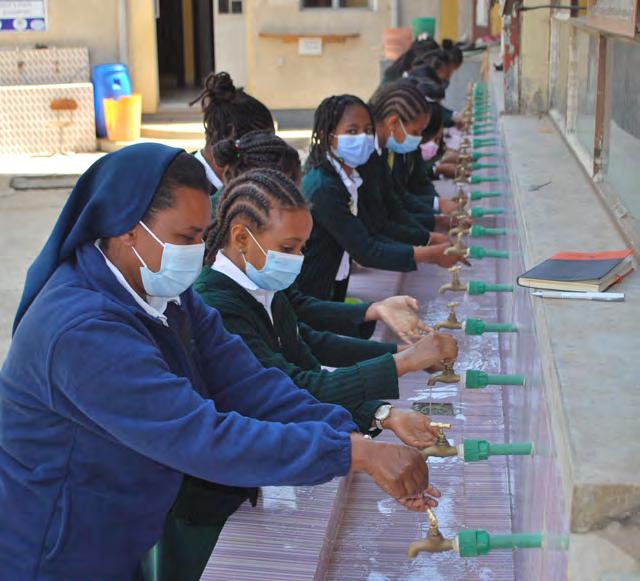
The Lord is my shepherd; I shall not want. He leads me beside still water … And my cup runneth over.
St. Mary’s School, Addis Ababa
Tanzania Mexico
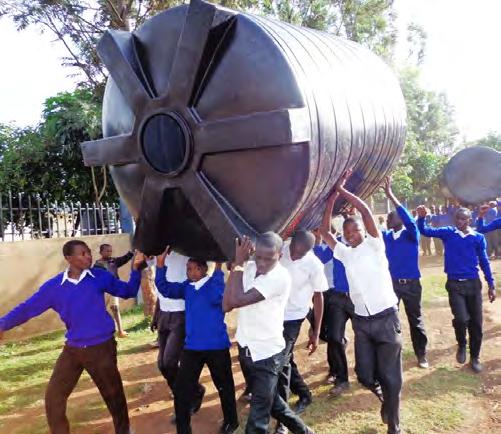
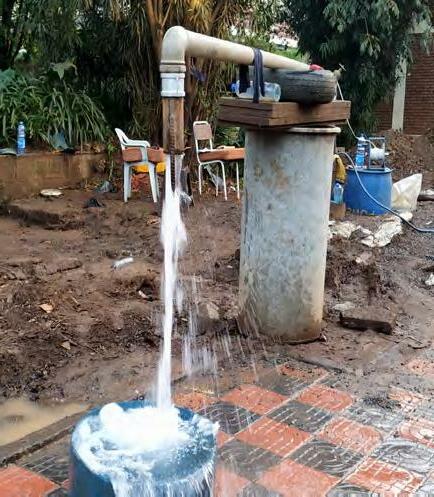
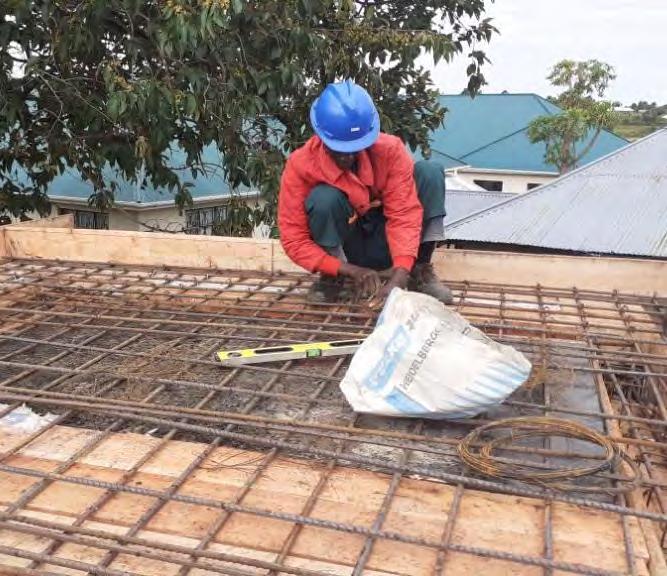
Ethiopia
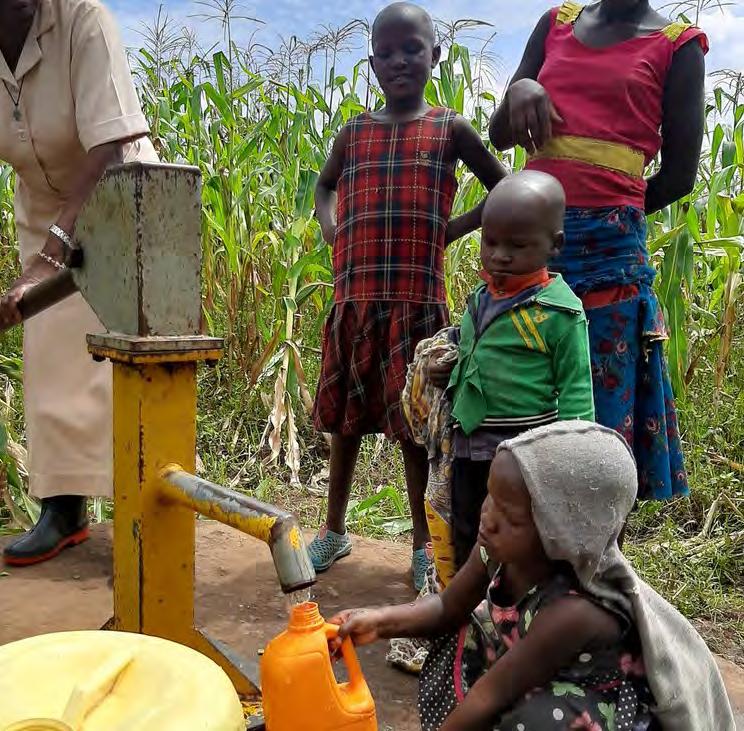
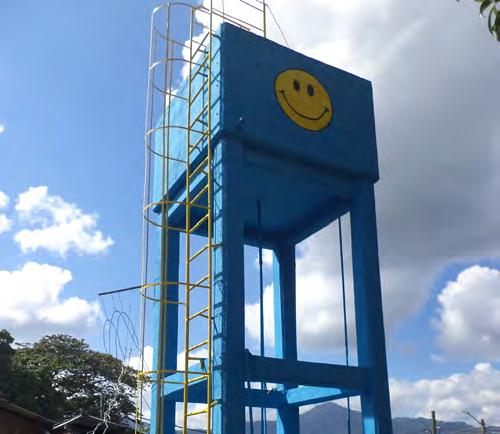
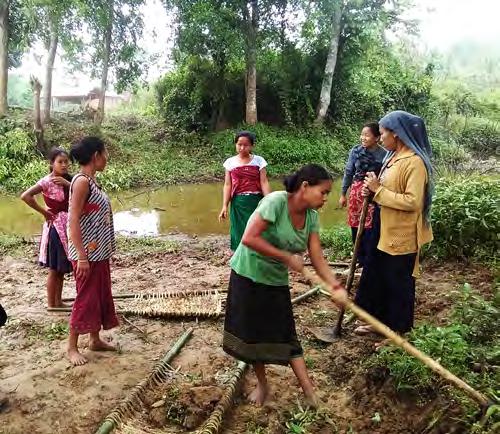
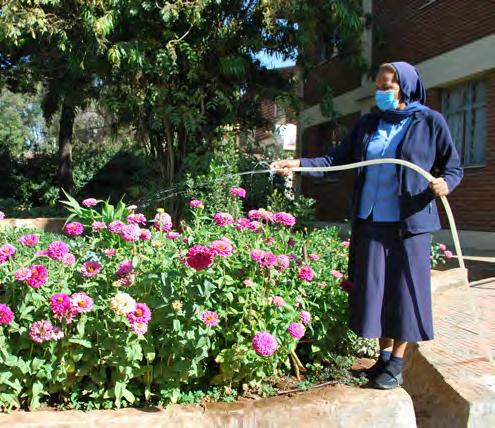
India Ethiopia
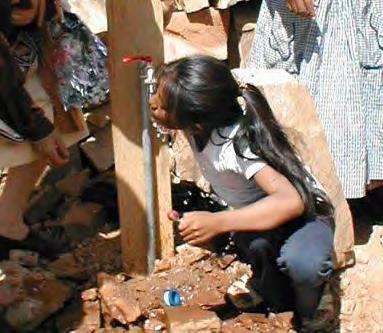
Bolivia Tanzania
DR Congo





